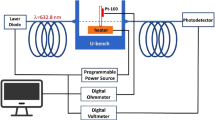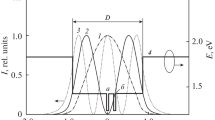Abstract
The results of experimental investigation into the dielectric losses in GaAs, InP:Fe, and Si semiconductor crystals in the millimeter wavelength range (80–260 GHz) using the original precise method of measuring the reflectance and dielectric-loss tangent tanδ based on open high-quality Fabry–Perot cavities are presented. It is shown that the losses in the frequency range from 100 to 260 GHz in ultrapure semiconductor single-crystal GaAs substrates are mainly determined by lattice absorption, while the main loss mechanism in single-crystal silicon is absorption by free carriers; herewith, tan δ ≈ (1–2) × 10–4 even for a noticeable, at a level of 1012 cm–3, free carrier concentration. In contrast with GaAs and Si, tanδ in compensated InP:Fe crystals is almost independent of frequency in the range from 100 to 260 GHz, which is associated with the material conductivity and optimization of microwave semiconductor devices, in particular, frequency-multiplication devices and devices of the controlled emission output of continuous and pulsed gyrotrons.



Similar content being viewed by others
REFERENCES
S. W. Smye, J. M. Chamberlain, A. J. Fitzgerald, and E. Berry, Phys. Med. Biol. 46, R101 (2001).
N. Dudovich, D. Oron, and Y. Silberberg, Nature (London, U.K.) 418 (6897), 512 (2002).
B. E. Cole, J. B. Williams, B. T. King, M. S. Sherwin, and C. R. Stanley, Nature (London, U.K.) 410 (6824), 60 (2001).
A. V. Gaponov, M. I. Petelin, and V. K. Yulpatov, Radiophys. Quant. Electron. 10, 794 (1971).
M. Thumm, J. Infrared, Millimeter, Terahertz Waves 41, 1 (2020).
M. Y. Glyavin, G. G. Denisov, V. E. Zapevalov, M. A. Koshelev, M. Y. Tretyakov, and A. I. Tsvetkov, Phys. Usp. 59, 595 (2016).
T. Idehara, S. P. Sabchevski, M. Glyavin, and S. Mitsudo, Appl. Sci. 10, 980 (2020).
E. A. Nanni, W. R. Huang, K.-H. Hong, K. Ravi, A. Fallahi, G. Moriena, R. J. Dwayne Miller, and F. X. Kärtner, Nat. Commun. 6, 8486 (2015).
B. M. Garin, in Proceedings of the ICMWFST’96, 4th International Conference on Millimeter Wave and Far Infrared Science and Technology (Beijing, China, 1996), p. 311.
B. A. Andreev, T. V. Kotereva, V. V. Parshin, V. B. Shmagin, and R. Heidinger, Inorg. Mater. 33, 1100 (1997).
J. A. Hejase, P. R. Paladhi, and P. P. Chahal, IEEE Trans. Compon. Packaging, Manuf. Technol. 1, 1685 (2011).
J. Krupka, J. Breeze, A. Centeno, N. Alford, T. Claussen, and L. Jensen, IEEE Trans. Microwave Theory Tech. 54, 3995 (2006).
J. Krupka, J. G. Hartnett, and M. Piersa, Appl. Phys. Lett. 98, 112112 (2011).
L. N. Alyabyeva, E. S. Zhukova, M. A. Belkin, and B. P. Gorshunov, Sci. Rep. 7, 7360 (2017).
B. M. Garin, V. V. Parshin, S. E. Myasnikova, and V. G. Ralchenko, Diamond Relat. Mater. 12, 1755 (2003).
R. Golovashchenko, V. Derkach, and S. Tarapov, Radiofiz. Elektron. 20 (4), 31 (2015).
J. Molla, R. Vila, R. Heidinger, and A. Ibarra, J. Nucl. Mater. 258–263, 1884 (1998).
M. Kulygin and G. Denisov, J. Infrared, Millimeter, Terahertz Waves 33, 638 (2012).
J. F. Picard, S. C. Schaub, G. Rosenzweig, J. C. Stephens, M. A. Shapiro, and R. J. Temkin, Appl. Phys. Lett. 114, 164102 (2019).
A. A. Vikharev, G. G. Denisov, V. V. Kocharovsky, S. V. Kuzikov, V. V. Parshin, N. Y. Peskov, A. N. Stepanov, D. I. Sobolev, and M. Y. Shmelev, Radiophys. Quant. Electron. 50, 786 (2007).
O. Madelung, Semiconductors: Data Handbook (Springer, New York, 2003).
V. V. Rumyantsev, K. V. Maremyanin, A. P. Fokin, A. A. Dubinov, V. V. Utochkin, M. Y. Glyavin, N. N. Mikhailov, S. A. Dvoretskii, S. V. Morozov, and V. I. Gavrilenko, Semiconductors 53, 1217 (2019).
Y. A. Dryagin and V. V. Parshin, Int. J. Infrared Millimeter Waves 13, 1023 (1992).
A. F. Krupnov, M. Y. Tretyakov, V. V. Parshin, V. N. Shanin, and M. I. Kirillov, Int. J. Infrared Millimeter Waves 20, 1731 (1999).
V. V. Parshin, M. Y. Tretyakov, M. A. Koshelev, and E. A. Serov, Radiophys. Quantum Electron. 52, 525 (2010).
V. N. Shanin, V. V. Dorovskikh, M. Y. Tretyakov, V. V. Parshin, and A. P. Shkaev, Instrum. Exp. Tech. 46, 798 (2003).
E. V. Koposova, S. E. Myasnikova, V. V. Parshin, and S. N. Vlasov, Diamond Relat. Mater. 11, 1485 (2002).
A. F. Krupnov, M. Y. Tretyakov, V. V. Parshin, V. N. Shanin, and S. E. Myasnikova, J. Mol. Spectrosc. 202, 107 (2000).
N. F. Mott and E. A. Davis, Electronic Processes in Noncrystalline Solids (Oxford Univ. Press, London, 1971).
K. Khirouni, H. Maaref, J. C. Bourgoin, and J. C. Garcia, Mater. Sci. Eng. B 22, 86 (1993).
Funding
This study was supported by the Russian Scientific Foundation, project no. 18-79-10112. The statement of the problem on using semiconductor mirrors in the compression circuit of pulses of megawatt gyrotrons for the high-gradient acceleration of particles and evaluation of the main parameters of semiconductors required to solve this problem are formulated in the Russian Science Foundation project no. 19-79-30071.
Author information
Authors and Affiliations
Corresponding author
Ethics declarations
The authors declare that they have no conflict of interest.
Additional information
Translated by N. Korovin
Rights and permissions
About this article
Cite this article
Maremyanin, K.V., Parshin, V.V., Serov, E.A. et al. Investigation into Microwave Absorption in Semiconductors for Frequency-Multiplication Devices and Radiation-Output Control of Continuous and Pulsed Gyrotrons. Semiconductors 54, 1069–1074 (2020). https://doi.org/10.1134/S1063782620090195
Received:
Revised:
Accepted:
Published:
Issue Date:
DOI: https://doi.org/10.1134/S1063782620090195




